
Chelidonura punctata
Eliot, 1903
Order: CEPHALASPIDEA
Family: Aglajidae
DISTRIBUTION
Known previously from only Tanzania and Madagascar in the western Indian Ocean, records on the Forum show it occurs from South Africa in the south across to Thailand and Burma in the north east of the Indian Ocean.
PHOTO
Bongoyo Is, Dar es Salaam, Tanzania, November, 1976. PHOTO: Bill Rudman.
This species is easily identified by its large yellow-orange spots.
See also Chelidonura sp. 7
-
Rudman,W.B., 1973. On some species of Chelidonura (Opisthobranchia: Aglajidae) from Zanzibar and Fiji. Zoological Journal of the Linnean Society, 52: 201-215.
Rudman, W.B., 1998 (October 14) Chelidonura punctata Eliot, 1903. [In] Sea Slug Forum. Australian Museum, Sydney. Available from http://www.seaslugforum.net/find/chelpunc
Related messages
Chelidonura punctata from Mayotte
December 23, 2009
From: Fabrice Schubert

Dear Bill,
We have a dilemma about this Chelidonura. We hope to solve it with your help.
Locality: Musical beach, 8m, Mayotte (french indian ocean island), Indian Ocean, 22 December 2009, muddy. Length: 5 mm. Photographer: Fabrice Schubert.
Thanks
Fabrice SCHUBERT
fabmanu.plongee@gmail.com
Schubert, F., 2009 (Dec 23) Chelidonura punctata from Mayotte. [Message in] Sea Slug Forum. Australian Museum, Sydney. Available from http://www.seaslugforum.net/find/23017Dear Fabrice,
This is Chelidonura punctata which is found in the western Indian Ocean and around the northern Indian Ocean to Thailand.
Best wishes,
Bill Rudman
Chelidonura punctata from Madagascar
November 16, 2009
From: Eric van Poppel
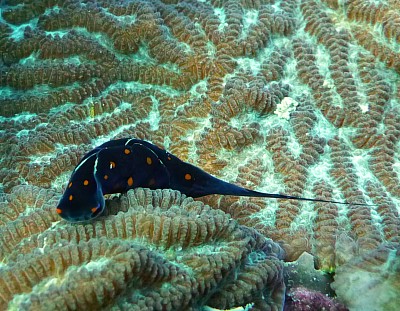
Could someone identify this nudibranch?
Locality: Nose Be, 12 meters, Madagascar, Indian Ocean, 20 September 2008, On reef. Length: 3-4 cm. Photographer: Eric van Poppel.
Eric van Poppel
don.vanpoppel@wildlifelands.com
van Poppel, 2009 (Nov 16) Chelidonura punctata from Madagascar. [Message in] Sea Slug Forum. Australian Museum, Sydney. Available from http://www.seaslugforum.net/find/22788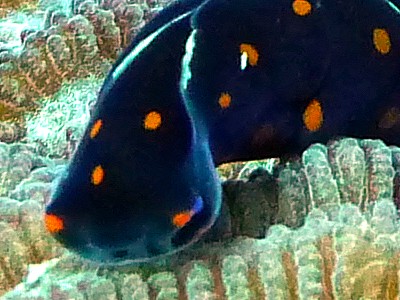
Dear Eric,
This is Chelidonura punctata. It is not a nudibranch, but belongs to a related group of sea slugs called cephalaspidians or Bubble Shells because many of the group have external, bubble-shaped, shells. Until quite recently we had no idea what species of Chelidonura ate, and because they were often found and photographed on large coral colonies - like in your photo - authors of many colour picture books wrote that they fed on coral mucus! We now know they feed on small flatworms, and the most likely reason they are found on large corals, is because small flatworms occur there as well.
Species of Chelidonura, and other members of the family Aglajidae, have unique sensory bristles arranged in clusters around their mouth - which apparently are used to sense the chemical trails of flatworms. I have included a closeup alongside to show 3 of these clusters as whitish patches on the front of the head. You can see them more clearly in some wonderful photos of C. flavolobata in message #16039.
Best wishes,
Bill Rudman
Chelidonura punctata from South Africa
September 7, 2007
From: Valda Fraser
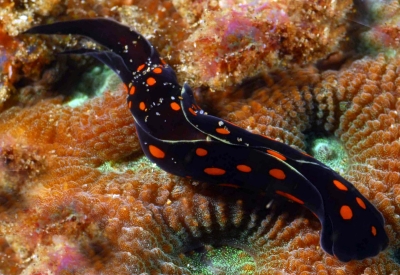
Dear Bill
Think this is Chelidonura punctata. Great that it occurs in our waters.
Locality: Sodwana, 16 m, South Africa, Indian Ocean, February 2007, Reef. Length: 20 mm. Photographer: Valda Fraser.
Please confirm identification.
Regards
Valda Fraser
valdafraser@mweb.co.za
Fraser, V.J., 2007 (Sep 7) Chelidonura punctata from South Africa. [Message in] Sea Slug Forum. Australian Museum, Sydney. Available from http://www.seaslugforum.net/find/20658Dear Valda,
It is good to get another record to complement Colin Ogden's [#14132] record from what I guess will be near the southern limits of its distribution. Previously known only from Tanzania and Madagascar, contributors to the Forum have greatly increased the known distribution of this species from South Africa in the south across to Thailand and Burma in the north east of the Indian Ocean.
Best wishes,
Bill Rudman
Breeding aggregation of Chelidonura punctata
May 2, 2006
From: Wannapa Thammasangwan
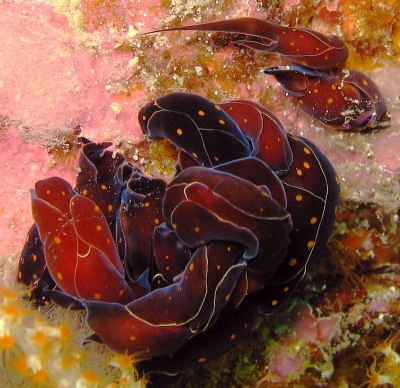

Concerning message #16377:
Dear All,
I am fond of nudibranchs and whenever I dive I often look for them. On 12-17 April 2006 I took a trip to the South Andaman Coast starting from Phuket to Li-pe Island. We had a great trip exploring sea creatures and we were amazed with how wonderful they are.
By the way, while the other 5 in my group swam one way, another friend and I went another way. The group of five encountered a whaleshark up close, while my buddy and I found some lovely and tiny creatures.
I am not sure of what I saw. Please kindly see the attached picture and inform if they were mating or what. I saw some singles around the bush which I didn't recognize. At first, I thought the bush was the eggs they laid but when I zoomed my photos, I found that it looked like ten or more of them cuddling together.
Locality: Ha Yai Island, 10-15 M. , Thailand, South Andaman, 15 April 2006, Rock. Length: 3-5 cms. Photographer: Wannapa Thammasangwan.
I think they are the Chelidonura punctata as well?? I will appreciate if I get a reply on this.
Best regards,
Jose
Koihidekun@hotmail.com
Wannapa Thammasangwan, 2006 (May 2) Breeding aggregation of Chelidonura punctata. [Message in] Sea Slug Forum. Australian Museum, Sydney. Available from http://www.seaslugforum.net/find/16512
Dear Jose,
I am sorry you missed the whale shark experience but I am glad you found this interesting cluster of Chelidonura punctata. They are definitely mating. In the close-up of one of your photos alongside you can see three animals forming a mating ring. Species of Chelidonura have their penis on the right side of the head and their female genital opening on the right side, about two-thirds of the way down the body. If you see and animal with its head on the right side just under the parapodial flap then you can be pretty sure it is mating. As they are hermaphrodites they can act as male and female at the same time. In this photo all three animals appear to be mating simultaneously.
There is a photo on the Forum showing three Chelidonura livida mating in a chain [see message #8036]. The Sea Hares are another group which can mate in chains like this [see Mating Chain Fact Sheet].
I am not sure if groups of Chelidonura together like this can be compared with the huge aggregations we sometimes find with Sea Hares [see Mass Mortality Fact Sheet]. I think the ecology of hunting carnivores would be different from that of grazing herbivores like the Sea Hares. Perhaps the Chelidonura were attracted by a population explosion of small flatworms. which they eat. We still have much to learn about these animals. They may be a lot smaller than Whale Sharks but they are just as fascinating.
Best wishes,
Bill Rudman
Chelidonura punctata from Thailand
April 18, 2006
From: Vie Panyarachun
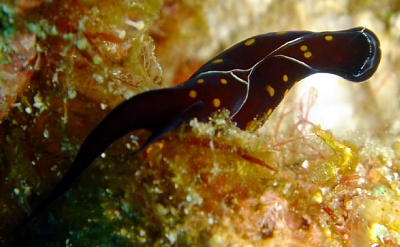
I photograhed this animal a few days ago and would like a species ID please. Thank you.
Locality: Tachai Pinnacle near Ko Tachai, 13 metres, Thailand, Andaman Sea, 15 April 2006, hard coral/rubble. Length: approx. 2.5 cm. Photographer: Vie Panyarachun.
Vie Panyarachun
vpanyarachun@hotmail.com
Panyarachun, V., 2006 (Apr 18) Chelidonura punctata from Thailand. [Message in] Sea Slug Forum. Australian Museum, Sydney. Available from http://www.seaslugforum.net/find/16377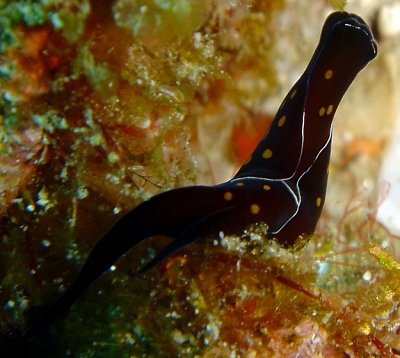
Dear Vie,
This is a nice find. It is a species, Chelidonura punctata which was only known from East Africa until the Forum participants started finding it as far east as Burma and Thailand. It is a good example of how interested amateurs can play an important role in building up our knowledge of these animals.
Best wishes,
Bill Rudman
Chelidonura punctata from Burma
July 16, 2005
From: Sergey Parinov
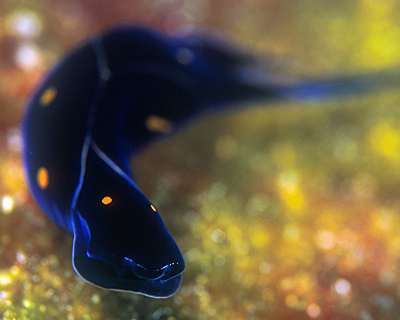
Dear Bill,
Here is a record of Chelidonura punctata from Mergui Archipelago.
Locality: South Mergui, Myanmar [Burma], Indian Ocean, [Andaman Sea].
Depth: 20 m. Length: 5 cm. February 2004. rocks. Photographer: Sergey Parinov
Sergey Parinov
http://www.sergeyphoto.com/underwater.html
webmaster@sergeyphoto.com
Sergey Parinov, 2005 (Jul 16) Chelidonura punctata from Burma. [Message in] Sea Slug Forum. Australian Museum, Sydney. Available from http://www.seaslugforum.net/find/14201Thanks Sergey,
As we get more records from the Andaman Sea region it is interesting to see how many species previously considered to be endemic to the western Indian Ocean have a distribution extending along the northern coasts of the Indian Ocean to Thailand and Burma
Best wishes,
Bill Rudman
Chelinodura punctata from Reunion Island?
July 2, 2005
From: Philibert Bidgrain

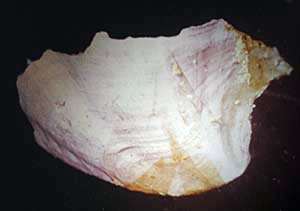
Dear Bill,
Reunion Island sea slugs.
We find this specimen only in November to December in a permanent pool on the rocky coast at Cap "la Houssaye". The maximun length of this animal is about 25 mm and the shell length is 7 mm. I think that it's Chelidonura punctata, with its relatively large yellow-orange spots. How does it differ from C. sandrana, which is also present in our area.
Locality: Saint Paul, Reunion island. Indian Ocean. Length: max 25 mm.
Photographer: Maurice Jay
Best Regards
Philibert Bidgrain
vieoceane.free.fr/runseaslug/indexslug.htm
vieoceane@free.fr
Bidgrain, P., 2005 (Jul 2) Chelinodura punctata from Reunion Island?. [Message in] Sea Slug Forum. Australian Museum, Sydney. Available from http://www.seaslugforum.net/find/14150Dear Philibert,
Yes this is Chelidonura punctata. The main colour difference with C. sandrana is that the yellow spots in that species, if present, are much smaller and are not found on the ventral surface, while in C. punctata the spots are relatively large and do occur on the sole of the foot. C. sandrana is also usually smaller. Although it can reach 20 mm in length, it is seldom more than half that size.
One interesting thing about your photo is the yellowish brown stain in the water at the posterior end of its body. This is the secretion from its yellow gland, which is a gland found only in the Aglajidae. Like the purple gland found in the Sea Hares, its function is unknown.
Best wishes,
Bill Rudman
Chelidonura punctata in South Africa
June 27, 2005
From: Colin Ogden
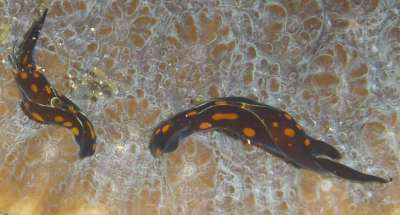
Hi Bill,
These photos were taken this morning on a dive here at Sodwana. I have allredy had a few sightings of this Nudi, but on checking on the forum and in Gosliner's book, I don't see it as having been reorded here in South Africa before. Gosliner records Chelidonura fulvipunctata, which appears quite different from this nudi. Is my ID correct, and have you had him from SA before.
Locality: Sodwana Bay, South Africa, Indian Ocean. Depth: 23 metres, Length: 30 mm. June 25 2005. Coral reef. Photographer: Colin Ogden
Regards
Colin
scubaco@iafrica.com

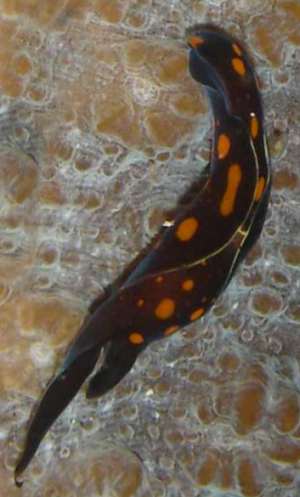
Dear Colin,
Your ID is correct, and yes I'm pretty sure this is a new record from South Africa. It is not a surprise that this species occurs on the tropical waters of eastern South Africa, but it is certainly good to have evidence. Can I assume you saw it crawling over this live coral colony? Why I ask is that there are many photos of species of Chelidonura crawling over corals like this is popular colour photo books, sometimes with captions suggesting they feed on the coral mucus. We now know that the reason they crawl over corals like this is to search for their prey - small flat worms which often occur on coral colonies in large numbers.
Best wishes,
Bill Rudman
Chelidonura punctata from Mauritius
November 11, 2002
From: Marina Poddubetskaia
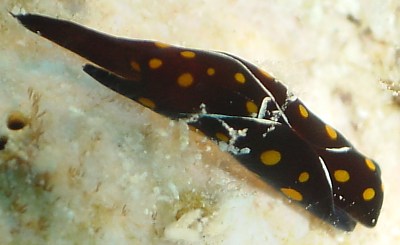
Dear Bill,
Here are some photos of Chelidonura punctata from Mauritius.
I saw several specimens in two or three diving sites: all of them was less than 15mm in size.
Pereybere, Mauritius, Indian Ocean. Site: Grand Aquarium. October 17, 2002. Depth: 11m (Upper Image). 10mm (Lower Images). Size: 10-12mm (Upper Image). 13-15mm (Lower Images). Photos: Marina Poddubetskaia - Nembro website
Best wishes,
Marina.
nembro@nembro.info
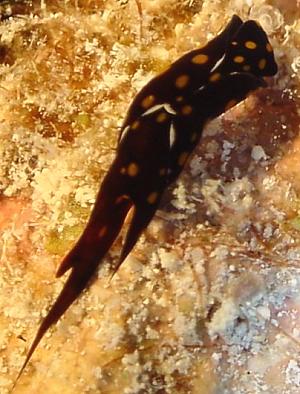
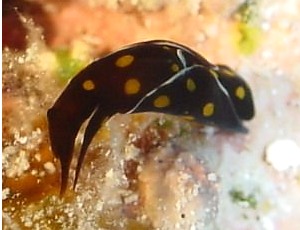
Thanks Marina,
Nice to get some more photos of this species from the western Indian Ocean
Best wishes,
Bill Rudman
Chelidonura punctata from Thailand
January 17, 2001
From: Erwin Koehler
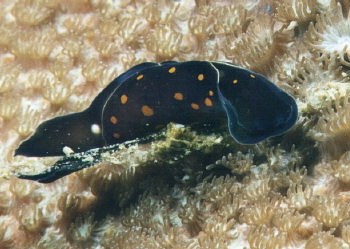
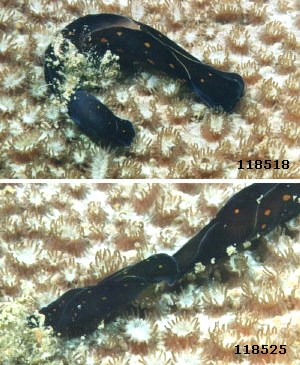
Hi Bill,
Here are the first photos from my recent trip to Thailand. On a coral of about 1m diameter were 6 individuals, size 23mm to 43mm. ek118518 shows 2 of them (23mm + 42mm) crawling out of some kind of jelly, I guess my flashlights disturbed them. ek118525 shows them crawling away "trailing" just like the genus Risbecia. The animal in the upper photo was 33mm long.
Depth 13m, Thailand, Phuket Island, divesite "Shark Point II", Dec. 17, 2000.
When I returned 2 weeks later to the same coral no individual was there.
Erwin
Medslugs.Koehler@t-online.de
Koehler, E., 2001 (Jan 17) Chelidonura punctata from Thailand. [Message in] Sea Slug Forum. Australian Museum, Sydney. Available from http://www.seaslugforum.net/find/3542Dear Erwin,
Thanks for this interesting information. Firstly with your earlier record from the Maldives, your finds are bringing Chelidonura punctata right across to the eastern side of the Indian Ocean.
'Trailing' in aglajids is quite a common phenomenon and often ends in mating. In aglajids the penis is on the right side of the head and the female genital opening is at the posterior end of the body. These animals therefore often mate 'head to tail' with the anterior one acting as female and the posterior one as male. Sometmes in the field, and often in captivity, aglajids will form mating chains of 5-10 animals with the most anterior one acting as female, the most posterior as male, and the ones in the middle acting as both male and female.
The jelly mass you describe them crawling out of is apparently a protective coat of mucus they often produce when they are resting or when they are disturbed. When crawling, aglajids secrete a coat of mucus which can cover their whole body, so they are really crawling along in a tube of mucus. When still this coat can increase to form a temporary 'nest'.
Best wishes,
Bill Rudman.
Chelidonura punctata from the Maldives
October 10, 2000
From: Erwin Koehler
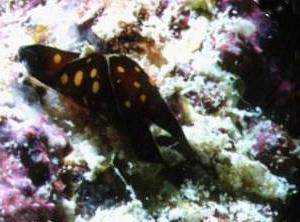
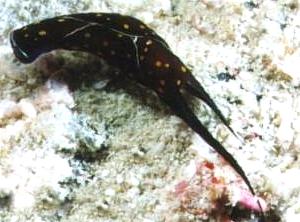
Dear Bill,
These photos are from my recent trip to the Maldives (which are recovering slowly from El Nino, i.e. the corals are growing again). Both were about 15 cm apart from each other at 25 m depth.
EK114911 is 17mm,
EK114912 is 22 mm long.
South Male Atoll, Guraidhoo Island, divesite
"Guraidhoo Out",
September 17, 2000.
Erwin
Medslugs.Koehler@t-online.de
Koehler, E., 2000 (Oct 10) Chelidonura punctata from the Maldives. [Message in] Sea Slug Forum. Australian Museum, Sydney. Available from http://www.seaslugforum.net/find/3156Dear Erwin,
This is Chelidonura punctata, a spectacularly coloured species of Chelidonura which seems to be restricted to the Indian Ocean.
Best wishes,
Bill Rudman.
